Press release September 22, 2005
Signs of magmatic activity in Central Europe observed for the first time
Scientists find a new explanation for earthquake swarms in the Vogtland region
Beneath the Cheb Basin on the German-Czech border there is an increase in the movement of magma towards the earth’s surface. This is the conclusion drawn by scientists from the UFZ Centre for Environmental Research (Umweltforschungszentrum Leipzig-Halle) and Germany’s national research centre for geosciences, the GeoForschungsZentrum Potsdam (GFZ). The verdict was reached after scientists undertook studies of rising gases in the mofettes and mineral springs in the area. Measurements taken over a period of 12 years showed that the ratio of two helium isotopes in these gases was changing. “The measurements produced the highest values in Europe north of the Alps – such as are usually only associated with active volcanic areas”, explained Dr Karin Bräuer of the UFZ.
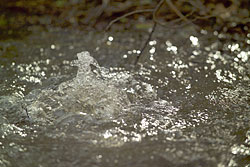
The Bublák mofette in the Eger Basin, Czech Republik
Foto: André Künzelmann/UFZ
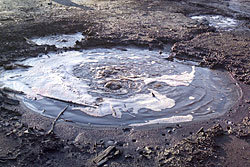
Mofettes in the nature reserve Soos near Frantiskovy Lazne, Czech Republik
Foto: André Künzelmann/UFZ
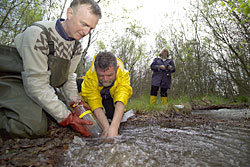
Scientist taking gas samples from the mofette
Foto: André Künzelmann/UFZ
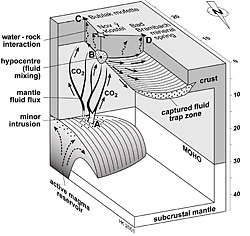
Figure: The way of the gas from the magma bubbles to the surface in the Eger Basin
Source: Dr. Horst Kämpf/GFZ
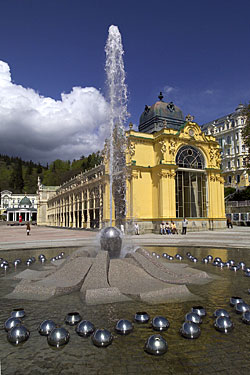
The world-famous spas of Bohemia, such as Mariánské Láznì
Foto: André Künzelmann/UFZ
For the scientists, these changes are a sign of increased magmatic activity beneath the Cheb Basin. The rising magma could also be one of the causes of the earthquake swarms, which regularly occur in the Vogtland, North-West Bohemia, the Fichtelgebirge and the Upper Palatinate.
The results of the studies will be presented in early October at the 8th International Conference on Gas Geochemistry in Palermo and published in the internationally renowned journal, Geophysical Research Letters (GRL Vol. 32 in 2005).
Breath from the deep
In a marshy area near Franti¨kovy Láznì (Franzensbad) in western Bohemia there is a waterhole where bubbles of gas constantly rise to the surface of the water. The locals have a name for it – Bublák, meaning “The Gurgler”. Well hidden amongst the bushes it is barely visible, but you can’t miss the sounds it makes as large volumes of gas rise up from the depths. The gas originates from active magma bubbles around 30 kilometres under the earth’s surface. Over the last few years scientists have studied mineral springs and gas-emitting holes (known as mofettes) throughout this area on the borders of Saxony, Bavaria and Bohemia. The most interesting of these is the Bublák mofette in the Eger Basin. Here scientists have found a place where gas rises more or less spontaneously from the earth’s mantle to the surface. “Measurements taken before and after a minor earthquake allowed us to estimate how fast the gas moves”, recounts Dr Gerhard Strauch of the UFZ. “It rises towards the surface at speeds of up to 400 metres per day, at least for the last seven to eight kilometres. This means there must be fissures that go down to great depths. ” This is a lucky find, as the scientists are interested in a component of the gas which is only found in the mantle, that is deeper than 30 kilometres, in a particular composition and which can change on its way to the surface.
Together with his colleague, Dr Horst Kämpf from the GFZ Potsdam, Strauch leans over the waterhole. He lowers a funnel into the water and uses it to catch the bubbles of gas which he then draws through a tube to a gas collector known as a “gas mouse” – a cylinder with two openings made from special glass. His colleague, Kämpf, then holds this glass cylinder under cold water, so that no air can get in and contaminate the sample. Later, in the laboratory, the researchers will examine the gas, more than 99 per cent of which is carbon dioxide.
Gas as a volcano sensor
“The helium studies are being carried out in collaboration with our colleague, Dr Samuel Niedermann, of the GFZ Potsdam”, explains Dr Karin Bräuer of the UFZ. “Helium is a noble gas and is only present in very small quantities in these gases. However, it is the gas for which the origin can be traced most easily.” Helium occurs naturally as two stable isotopes. The helium isotopes have different numbers of neutrons in the nucleus. “The more common helium-4 is produced in the earth’s crust through radioactive decay, while helium-3 comes from the earth’s mantle. Thus the ratio of the two helium isotopes can tell us something about what depth the gas comes from.”
This might sound like a mathematical game, but there is a serious side to it: during earthquakes or volcanic activity more gases than usual rise from deeper layers to the earth’s surface. Analysing these gases improves our understanding of processes which take place out of sight in the crust and the mantle. However, the results so far are by no means sufficient to make accurate predictions about volcanic eruptions or earthquakes. Only measurements carried out over many years can help with this in the future.
Since the beginning of the 1990s, the scientists have been examining the ratio between helium-3 and helium-4 in different mineral springs in the border region around the Cheb Basin. Their work shows that the values in some locations here have risen significantly in the last few years. “In the Bublák mofette near the border with Saxony we have measured an isotope ratio which is as much as 6.2 times that found in helium in the air”, says Karin Bräuer. “This is the highest ever recorded in Central Europe. Values like this are otherwise only associated with active volcanoes, such as Mount Etna.” The comparative measurements from the Laacher See in the East Eifel showed no changes. To the researchers this means that something is happening underground in the area around the Cheb Basin. This is now the region with the highest proportions of mantle helium in Central Europe.
The last volcanic eruptions around what is now the border area between Saxony, Bohemia and Bavaria probably took place around 300,000 years ago.
Today a whole branch of tourism lives on the later effects of this volcanic activity. The world-famous spas of Bohemia, such as Karlovy Vary (Karlsbad), Mariánské Láznì (Marienbad) and Franti¨kovy Láznì (Franzensbad), the Saxon spa towns of Bad Elster and Bad Brambach and also Sibyllenbad in the forest of Bavaria’s Upper Palatinate owe their existence to the bubbling carbon dioxide mineral springs found there and thus to the underground magmatic activity. However, local people and visitors to the region should not be worried about the new measurements: “We don’t yet know the composition of the magma or how far the melt from more than 30 km below ground is rising into the earth’s crust. The signals from the gases in the springs do give us hints that something is going on in the hidden depths. But a lot more monitoring and extensive geological work needs to be done”, explains Horst Kämpf of the GeoForschungsZentrum.
Earthquake swarms
Flashback to 4 September 2000, half an hour after midnight: a muffled rumbling wakes the residents of Klingenthal in the Vogtland from their sleep. Glasses rattle in the cupboard. A slight trembling can be felt. An earthquake measuring 3 on the Richter scale shakes the border region. There is no major damage but the people of the Vogtland are nevertheless disturbed. Very slight earthquakes occur here about every three years and there are more serious ones every few decades. For example, in winter 1985/86 tremors were recorded up to a magnitude of 4.6.
“We were lucky that our measuring programme from spring 2000 to December 2003 included a prolonged period of seismic activity for four months in the autumn and winter of 2000”, says Karin Bräuer. “It meant we could demonstrate seismically linked changes in the isotopic composition of the gases.” When the earth moves in the Vogtland, the quakes are not particularly strong ones but they are persistent. Over a period of several weeks there can be thousands of minor tremors. The tensions and stresses are not released in one large earthquake but through a series of miniquakes. The scientists call this phenomenon an earthquake swarm. Earthquakes generally occur along the boundary where two tectonic plates meet, but the Vogtland is a long way from these tectonically active plate intersections. Now the gas studies may be able to provide an explanation for the occurrence of earthquake swarms in this region. Degassing magma rises from the mantle into the crust. “It could be that the ascent of the magma increases the pressure of carbon dioxide in some crust areas, triggering earthquake swarms at a depth of between six and 14 kilometres”, Bräuer explains the new theory.
New approaches in earthquake research
It may be hundreds of thousands of years before the ancient volcanoes spew fire again. Severe earthquakes are also not expected within this timeframe. However, minor earthquakes are likely to happen rather sooner. In recent years there has been further progress in geophysical research. However, material studies of these processes still lead something of a niche existence. “It is important that in future isotope geochemistry time-series measurements are afforded the same consideration as traditional earthquake research which operates seismological earthquake stations and networks world-wide. The two methods can complement one another very well and help to advance science”, says Horst Kämpf who, together with Gerhard Strauch, has been working on this research since the 1980s. “Isotope measurements have not been used much so far as they are comparatively expensive and time-consuming.” Added to this, it has not yet been possible to carry out the gas studies automatically – this is in contrast to the physical measurement methods, where the movement of a pointer is registered electronically and can be transmitted throughout the world within seconds via the internet.
The gas studies which have been carried out so far have been funded since 1992 by the German Research Foundation (Deutsche Forschungsgemeinschaft). However, from a geological perspective, standard funding periods of on average three years represent no more than a brief moment. In order to make definite statements about the earth beneath us, long-term studies are essential. Consequently, the scientists from Halle and Potsdam plan to take measurements every month in order to monitor the magmatic activity beneath the Cheb Basin.
Tilo Arnhold
Additional photos and video footage (mini DV) are available free of charge from the UFZ Press Office.
Further links
Conference GeoErlangen 2005 (24th to 29th September 2005 in Erlangen, Germany):
http://pal.pal.uni-erlangen.de/GV-DGG-2005/index.html8th International Conference on Gas Geochemistry in Palermo/Italy:
- www.copernicus.org/ICGG8/index.html
- www.cosis.net/abstracts (PDF; K. Bräuer)
- www.cosis.net/abstracts (PDF; G.Strauch)
- www.cosis.net/abstracts (PDF; H. Kämpf)
Further information on this subject is available from:
Dr. Karin Bräuer / Dr. Gerhard Strauch
Helmholtz Centre for Environmental Research – UFZ
Tel: +49 (0)345 558-5206
Dr. Horst Kämpf
GeoForschungsZentrum Potsdam (GFZ)
Telefon: +49 (0)331-288-1432
or
Doris Böhme / Tilo Arnhold,
Public Relations of Helmholtz Centre for Environmental Research – UFZ
Phone: +49-341-235-2278
E-mail: presse@ufz.de
